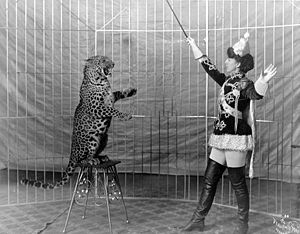Animal tamer

Early 20th century animal trainer and a leopard.
|
|
| Occupation | |
|---|---|
| Names | animal trainer |
| performing arts | |
|
Activity sectors
|
social science, busking, circus, show business |
| Description | |
| Competencies | skills, manual dexterity |
|
Education required
|
see professional requirements |
|
Fields of
employment |
police, education, entertainment |
|
Related jobs
|
Lion tamer; see related occupations |
Animal training refers to teaching animals specific responses to specific conditions or stimuli. Training may be for purposes such as companionship, detection, protection, and entertainment. The type of training an animal receives will vary depending on the training method used, and the purpose for training the animal. For example, a seeing eye dog will be trained to achieve a different goal than a wild animal in a circus.
In some countries animal trainer certification bodies exist. They do not share consistent goals or requirements; they don't prevent someone from practicing as an animal trainer nor using the title. Similarly, the United States does not require animal trainers to have any specific certification. An animal trainer should consider the natural behaviors of the animal and aim to modify behaviors through a basic system of reward and punishment.
During training, an animal trainer can administer one of four potential consequences for a given behavior:
Behavior analysts emphasize the use of positive reinforcement for increasing desirable behaviors and negative punishment for decreasing undesirable behaviors. If punishment is going to be used to decrease an undesirable behavior, the animal must be able to receive positive reinforcement for an alternative behavior.
Reinforcement should be provided according to a predetermined schedule. Such a schedule of reinforcement specifies whether all responses or only some are reinforced and includes the following:
While continuous reinforcement in a fixed ratio schedule may be necessary for the initial learning stages, a variable ratio schedule is the most effective at maintaining behavior over long periods of time.
There are various methods animal trainers can use to prompt an animal to respond to a stimulus in a specific way. For example, shaping is a process by which successive approximations are rewarded until the desirable response topography is attained. An animal trainer can use conditioned reinforcers, like clickers, to bridge the interval between response and positive reinforcement. Some stimuli that is considered discriminative are signals, targets and cues. They can be used to prompt a response from an animal, and can be changed to other stimuli or faded in magnitude. In order to delay satiation, reinforcer size should be as small as possible and still be effective for reinforcement. Also, the timing of the delivery of a reinforcer is crucial. Initially the interval between response and consequence must be minimal in order for the animal to associate the consequence with the response.
...
Wikipedia
